An insight into the ecology of Manasbal Lake of Kashmir valley: A Review
1
Fish Biology and Limnology Research Laboratory Department of Zoology,
University of Kashmir,
Srinagar,
Jammu and Kashmir,
India
Corresponding author Email: yahya.bakhtiyar@gmail.com
DOI: http://dx.doi.org/10.12944/CWE.19.2.3
Copy the following to cite this article:
Yousuf T, Javaid S, Nissar S, Mir Z. A, Bakhtiyar Y. An insight into the ecology of Manasbal Lake of Kashmir valley: A Review. Curr World Environ 2024;19(2). DOI:http://dx.doi.org/10.12944/CWE.19.2.3
Copy the following to cite this URL:
Yousuf T, Javaid S, Nissar S, Mir Z. A, Bakhtiyar Y. An insight into the ecology of Manasbal Lake of Kashmir valley: A Review. Curr World Environ 2024;19(2).
Download article (pdf) Citation Manager Publish History
Select type of program for download
| Endnote EndNote format (Mac & Win) | |
| Reference Manager Ris format (Win only) | |
| Procite Ris format (Win only) | |
| Medlars Format | |
| RefWorks Format RefWorks format (Mac & Win) | |
| BibTex Format BibTex format (Mac & Win) |
Article Publishing History
| Received: | 2024-06-12 |
|---|---|
| Accepted: | 2024-08-30 |
| Reviewed by: | 
 Saltanat Parveen
Saltanat Parveen
|
| Second Review by: |

 Rahul Kumar Khadwalia
Rahul Kumar Khadwalia
|
| Final Approval by: | Dr. Gopal Krishan |
Introduction
Manasbal Lake is the deepest freshwater lake in Kashmir1 that harbors a profitable fishery and provides multiple recreational opportunities. The marl lake is globally known for its scintillating clear water, picturesque beauty, and pink lilies with elegant mountains present behind the lake, adding more charm to its beauty, thus popularized as the “Supreme Gem of all Kashmir lakes”2. The bloom of Nelumbo nucifera at the border of the water body (during July and August) enhances the lake's natural attractiveness. This lake supports a diverse population of aquatic birds and is recognized as one of the largest stamping grounds for these species in Kashmir, making it a popular destination for bird watching3,4. Despite being a significant socio-economic asset, its environment is deteriorating due to upstream agricultural runoff, municipal waste, deforestation, changes in land use and land cover, limestone kilns, and stone quarrying, collectively contributing to the lake's eutrophication5,6. Eutrophication that causes algal growth produced by fluctuating nutrient equilibrium has a bad impact on the water quality and biotic life7 leading to the deterioration of the sheen and charm of the lake. The Manasbal Lake forms a complex inland system with plentiful assets such as the fishes, lotus, and Nadru (lotus stem consumed as a local vegetable). The water of Manasbal Lake is clearer than that of Dal Lake and is the key resource for fishing and for getting food stuff and silage plants. Navigation, transport and boating as well as tourism are other advantages derived from the pristine lake therefore it contributes an appreciable share to the economy of the region8, besides comprising indispensable biodiversity.
This study provides a comprehensive analysis of the ecology of the Manasbal Lake, highlighting unique contributions that advance ecological understanding and inform sustainable management practices. The paper examines long-term data trends in abiotic factors and identifies significant changes in various parameters like water temperature, pH, dissolved oxygen, and nutrient concentrations, providing insights into the lake's seasonal and interannual variability. The impact of anthropogenic activities (human settlements, agricultural runoff, tourism, and stone quarrying) is also meticulously detailed in the current study, which helps pinpoint the primary sources of pollution and eutrophication, guiding targeted interventions. The study proposes evidence-based strategies for mitigating pollution, regulating human activities, and restoring the lake's ecological balance. These recommendations are grounded in scientific data, enhancing their relevance and applicability for policymakers and conservationists. Overall, this study not only advances the ecological understanding of Manasbal Lake but also provides a critical foundation for developing sustainable management practices that can preserve the lake's ecological integrity for future generations.
Description of lake
Manasbal Lake, a prominent warm monomictic lake 9,10,11 is located in the Safapora village of district Ganderbal of Central Kashmir, approximately 30 km to the Northwest of Srinagar city, located within the coordinates of North latitude 34°14'50.94? and East longitude 74°40'17.12'' with 1583 m a.s.l, altitude12,13 shown in Figure 1. However, the western and southwestern parts show a slight dip to approximately 1551 m.a.s.l. The maximum area has a slope from 0o to 16.86o however increase in the slope that ranges from 16.87o to 33.72o has been observed due to human interference and other settlements. The surface area of the lake is approximately 280 ha of which 25 ha is marshy14. The maximum depth is about 13m with fresh water addition through precipitation, groundwater, and springs as the lake is without distinct inlet, and the excess water is discharged to the Jhelum River5. The shape of this deepest lake is oblong with the highest length and breadth of 3.5 km and 1.5 km respectively14. The volume of water has been estimated as 12.8 × 106 m3 1,15 and the residence time of water is calculated as 1.2 years16 which is considered as a moderate level time for renewal of lake water. The sedimentation rate of Manasbal Lake is 0.44 cm/year17.
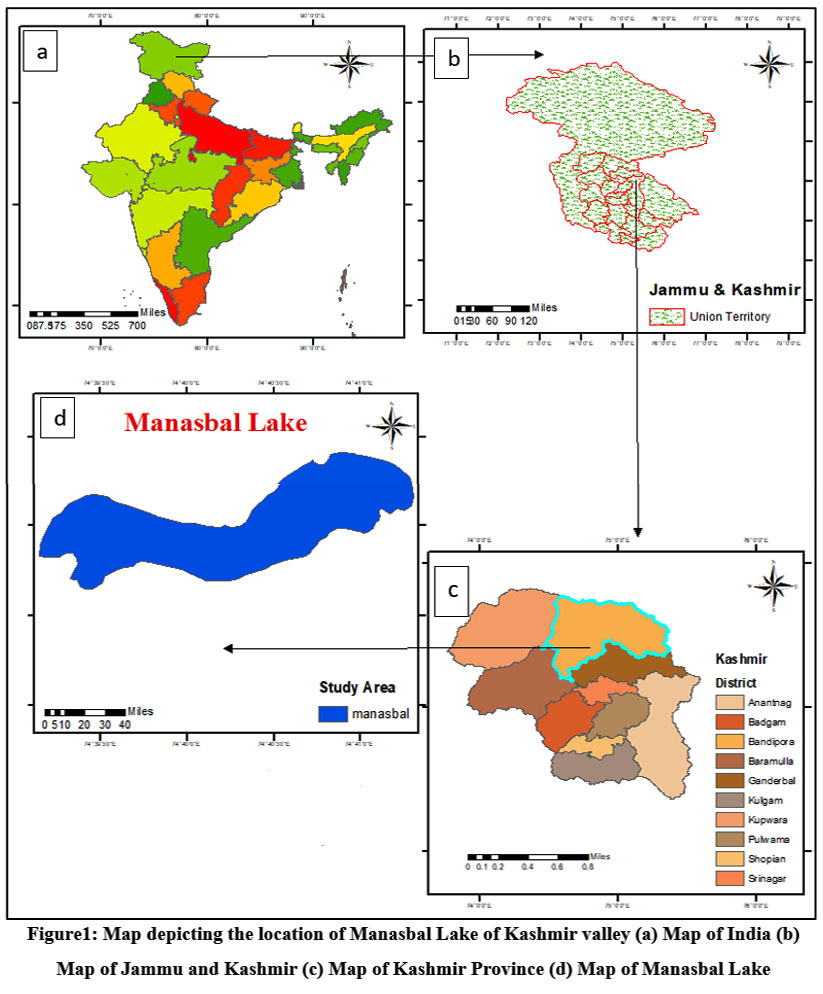 | Figure 1: Map depicting the location of Manasbal Lake of Kashmir valley (a) Map of India (b) Map of Jammu and Kashmir (c) Map of Kashmir Province (d) Map of Manasbal Lake
|
Manasbal Lake which is defined as a marl lake, has predominantly rural surroundings18, flanked by three villages viz, Jarokha Bal, Gratabal and Kondabal besides forming a prominent inland reservoir for the dwellers for various purposes like drinking, and agrarian practices19. Among the villages, Kondabal village is very significant keeping in view the condition and vigor of the lake. Kondabal (Kond stands for Kiln and bal is place) is the place of kilns, quarries, and mines known for incorporation of the calcium into the lake and is located on Kondabal Hill18. Manasbal's climate is similar to that of a Sub-Mediterranean region, with warm summers and frigid winters. The lake is protected from India's monsoon by the 5000-meter-tall Pir Panjal Range, which provides precipitation from nearby clouds12. The are receives an annual precipitation of about 700 mm, chiefly in the form of snow during winters20. The Manasbal is the only lake in Kashmir that maintains constant summer stratification21. Its catchment is 22 sq. km in area18. On the eastern side, the Lake is supported by the extremely dissected hills (Baladar Mountains). Furthermore, to the north are lacustrine, fluviatile, and loessic deposits on a high plateau called "Karewa," and to the south are small, dissected hills called "Ahtung hills" that provide a view of the lake22. These hills are known as a source of limestone which is obtained through quarrying23. The drainage basin of Manasbal Lake occupies an area of 33 km2 and the streams are mostly seasonal except for the small, perennial channel of water known locally as Laar Kul that irrigates the agricultural land in its course, eventually draining into the lake on eastern side of the catchment area of Manasbal Lake6,18.
Drainage
It is a semi-drainage type of lake with no proper inflow channel and is fed mainly by more than 1,200 springs arising from the lake bed and precipitation mainly in the form of snow and rain (Jamila et al., 2014)5. However, the addition of water is also contributed by an irrigational stream; Laar Kul6,18. There is a regulated outflow channel viz., Nunnyar Nalla (1.6 km) through which water flows into the Jhelum River near Sumbal village4,18.
Catchment Area
The marginal area of the lake is spread over an area of about 22 sq. km 6 and its topography is curvy12. It mainly constitutes limestones of the Triassic era that are overlined with Panjal Traps and agglomerates followed by deposits of Karewa belonging to the Quaternary period along with freshly alluvium deposits. This area shows huge variations in its physical and relief features hence with considerable diversity in the soil formation process and geologic material. Glaciers and rivers are two main agents that account for the deposition of wide variety of soils ranging from alluvial to lacustrine and glacial22. The soil types include:
Karewa Soils: These are lacustrine soils that form a greater part of the catchment area, originated during the Plio-Pleistocene age, and are predominantly formed of yellow and beige-coloured sandy textured clay to some extent firmed with conglomerates and entrenched moraines24,25. These soils are less productive and present at an altitude between 1650-1850 m.a.s.l.
Young Mountain Soils: These soils are well-drained, immature soils found on the slopes of mountains having underdeveloped horizons with coarse texture. These soils show huge variations in humus content with context to different altitudes and slopes. These soils are prone to erosion lying at an altitude of 1800-3000 m.a.s.l.22
Loamy Soil: This is the most fertile type of soil found in the Manasbal catchment area hence predominantly used for rice cultivation. Loamy soils are deposited by rivers during floods in flat areas found at an altitude between 1500-1650 m.a.s.l.26
Land use/Land cover (LULC) types in the catchment are predominately represented by the barren wasteland that constitutes about 29.52%, agricultural land (17.85%), land covered with plantation shares at about 13.35%, water area at 7.61% and built-up area about 6.76%. Bare rock forms the least dominant land cover comprising about 0.42% (Figure 2). As more than 31% catchment area is constituted by wasteland bare rocks having quarrying sites, a huge amount of limestone sediments seeps into the lake system. Therefore, concerted endeavors should be made to reforest the barren regions with indigenous coniferous tree species such as Pinus wallichiana. This action aims to mitigate the sedimentation impact on the lake18,22. The lake catchment is surrounded by forests with moderate vegetation and sizeable margin of the lake is currently under paddy agriculture (Figure 3). Plantation includes Robinia pseudoacacia, Salix alba, Populus nigra, Juglans regi, besides rice cultivation is mainly seen in agricultural areas, orchards mainly representing apples and pasture predominantly representing grasses like Cynodon dactylon and Trifolium species6.
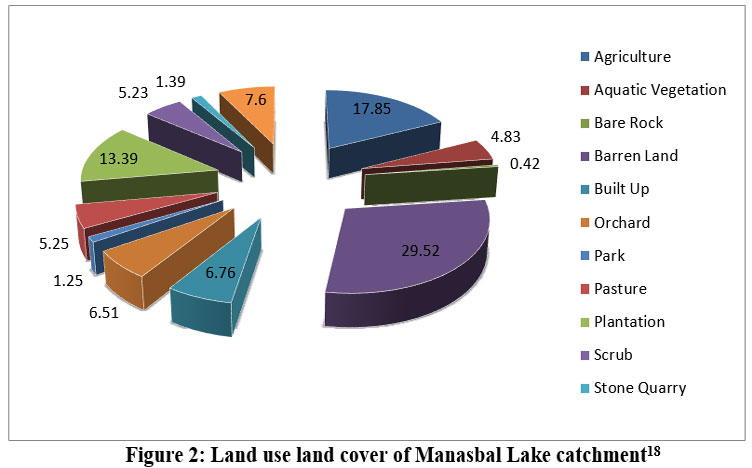 | Figure 2: Land use land cover of Manasbal Lake catchment18
|
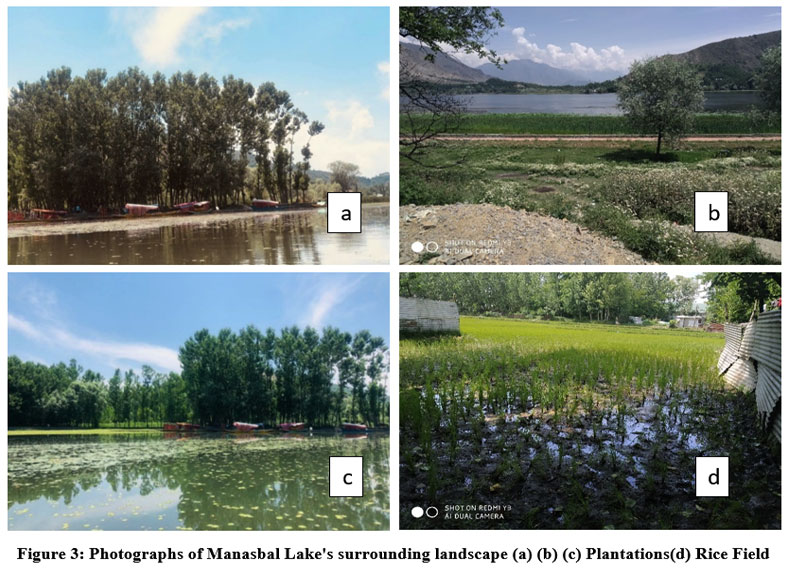 | Figure 3: Photographs of Manasbal Lake's surrounding landscape (a) (b) (c) Plantations (d) Rice Field
|
Sediment Composition
The sediments which constitute the base of the lake bed comprise mostly clayey texture with some silt and sand content. Through the analysis of the texture of loess resembling paleosol, the composition of particle size of the bottok samples of lake is indicative of dominance pattern of fractions as clay (49.79%) > silt (35.88%) > sand (14.33%) indicating a comparatively deeper and tranquil setting for sedimentation22. The clay fraction was found dominant because of no major drainage flow towards the lake. The north-east and south-west side of the lake contains a high percentage of clay while the southern part of the lake basin being dominated by silt and `0.the highest percentage of sand was shown along the north-east part of the lake and also along the inlet channels of its catchment. The sites with high human interference and along deeper columns of water show the dominance of clay whereas the lower water columns that are close to the margins of lake mainly comprise of sand. Major oxides (in terms of percentage) and trace elements composition (ppm) of sediments from Manasbal Lake are shown in Figure 4 and Figure 5, which suggest a blended origin of the lakebed sediments, influenced by the intricate tectonic conditions within the lake basin and its diverse catchment area.
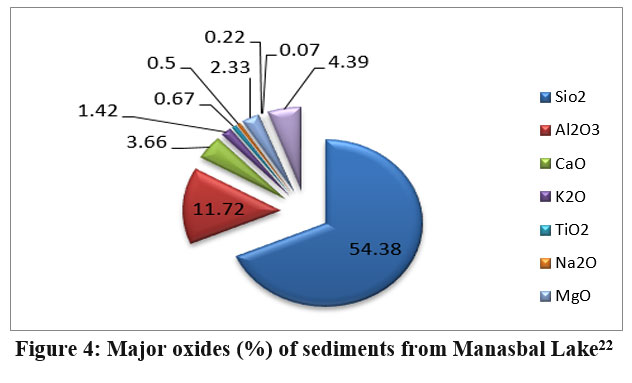 | Figure 4: Major oxides (%) of sediments from Manasbal Lake22
|
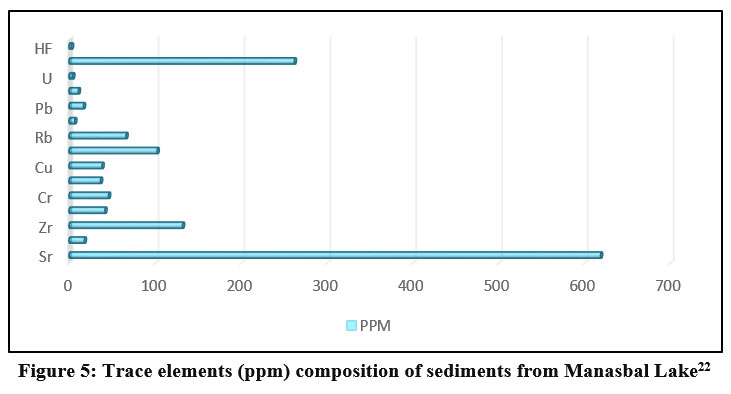 | Figure 5: Trace elements (ppm) composition of sediments from Manasbal Lake22
|
History and Tourism Potential
The origin of Kashmir valley has been studied by various workers over the period and provided significant number of evidences that eventually helped in figuring out the lacustrine origin of the Karewa deposits.27,28 The valley of Kashmir is regarded as an elliptical dun in the middle Himalayas composed of highly compacted and distorted rocks of different geographical era ranging from Carboniferous to the Eocene period29. Geological investigation carried out by De Terra and Paterson in 1939 revealed that the origin of Kashmir valley is due to the upliftment of the Pir Panchal range during few past million years that caused blockage of Himalayan rivers and resulted in the formation of a vast lake. The lithology of catchment constitutes the Triassic limestone represented by thick compact blue limestone, slates and dolomites19.
The name “Manasbal” has been taken from the name of Lake Manasarovar23. The lake origination is yet to be explored however there is no contradiction to the view that Manasbal Lake is very primitive. There is the myth that the lake is without a bottom and people have blind faith in it23. Garoka (bay window) is the Mughal Garden that was constructed by Nur Jahan signifying the charm of the lake. Manasbal Lake which is considered as non-monsoonal lake has shown the reversal of chronology because of presence of younger paleosols in the catchment area30.
Kashmir Valley continued to attract tourists of various casts and tones from its past years due to its indispensable natural beauty, holy sites and cultural structures. Although the economic condition of the valley majorly relies on farming and fruit cultivation, yet the tourism considered forms the mainstay of the economy because of the fact of creating more opportunities for employment and contributes 6.98 % of the state's GDP31. The main alluring places of Kashmir include Gulmarg and Pahalgam, gardens constructed by Mughal emperors, Lakes including Wular Lake, Dal Lake, Manasbal Lake, Nigeen Lake, historical sites like Amarnath, Hariparbat fort, Hazratbal shrine, Jamia Masjid, Makhdoom sahib etc. Therefore, Kashmir Valley is bestowed with an ample resource base which helps in expansion and endorsement of ecotourism. The soothing scenery of a lake makes it a great destination for relaxing and calming the soul. Particularly in summer months, the lotus bloom in plenty, wrapping the Lake surface in an ethereal glow. Manasbal Lake stands as a prominent attraction for Kashmir tourism. However, due to the lack of attention from responsible authorities and the self-interest of nearby residents, the lake's ecosystem has suffered significant disruptions and compromises32. Manasbal Park present on the eastern side of the lake offers some great views with beautifully manicured lawns and flower beds thus forming a picnic area. The presence of the Shiva temple on the southern side which has existed there since the 8th century CE is a desirable feature adding to beauty of Lake (Figure 6). Besides the Jharokha Bagh fortress gardens constructed by Noor Jehan (Queen of Mughal Emperor Jahangir) on the northern bank of the Manasbal Lake is admired destination by neighboring inhabitants and people across the world (Figure 6).
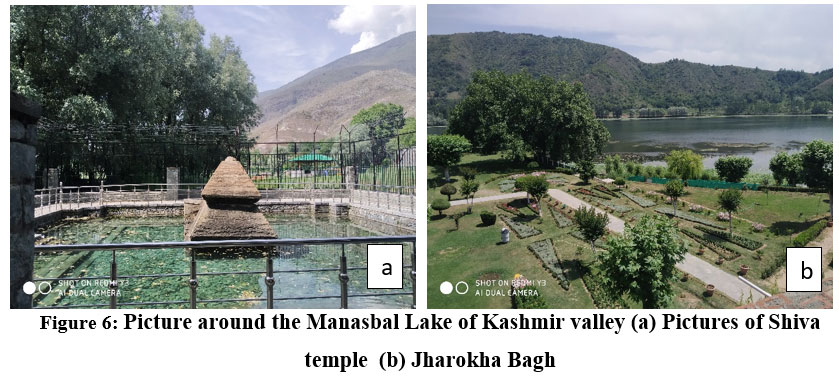 | Figure 6: Picture around the Manasbal Lake of Kashmir valley (a) Pictures of Shiva temple (b) Jharokha Bagh
|
Abiotic Components of the Manasbal Lake
Manasbal Lake is considered a warm monomictic lake due to its thermal behavior that resembles with Siwalik lakes33. The isothermal period due to seasonal variation in the temperature of lake water revealed an isothermal setting for January and February34,35. Qadri and Yousuf (1978)21 reported that the stratification of lake continues from March to November. The investigation of Vass (1973)36 has revealed that lake remains stratified during March and continuing until November and there is no inverse stratification occurring in the lake. Water temperature was found in the range of 4.4°C to 23.5°16,37,38.
The dissolved oxygen (DO) concentration in the surface waters of Manasbal Lake has been found to fluctuate between 8.6 mg/l (maximum) in February due to peak activity of photosynthesis and 6.8 mg/l (minimum) in month of July due to the fact of rising temperature of water and consumption rate, however the bottom of lake remains anoxious16,18,37. Sechii disc values indicate maximum light penetration values ranged from 3.35 to 4.58. Plankton suspension and growth in water, calm deposition of materials and increasing inflow of sewage and loading of dissolved organic matter in high quantity has been studied by various workers37,39,40,41.
The pH value of Manasbal Lake shows alkaline nature of the water with significant variation ranging from 7.29 - to 8.98, revealing high productivity of the lake16,42.
Variations in pH appeared to be correlated with fluctuations in the rates of photosynthesis and decomposition. The pH levels of this lake consistently registered higher values throughout all months, attributed to the introduction of calcium into the water from Kondabal.43
Electric conductivity of lake varied from 333 to 387 ?s/cm with a maximum value in month of July and a minimum value occurring in January that can be attributed to the sedimentation process happening in the lake at different periods throughout the year.16,37 Different workers reported the values of various physicochemical attributes of Manasbal Lake from years are shown in Table 1.
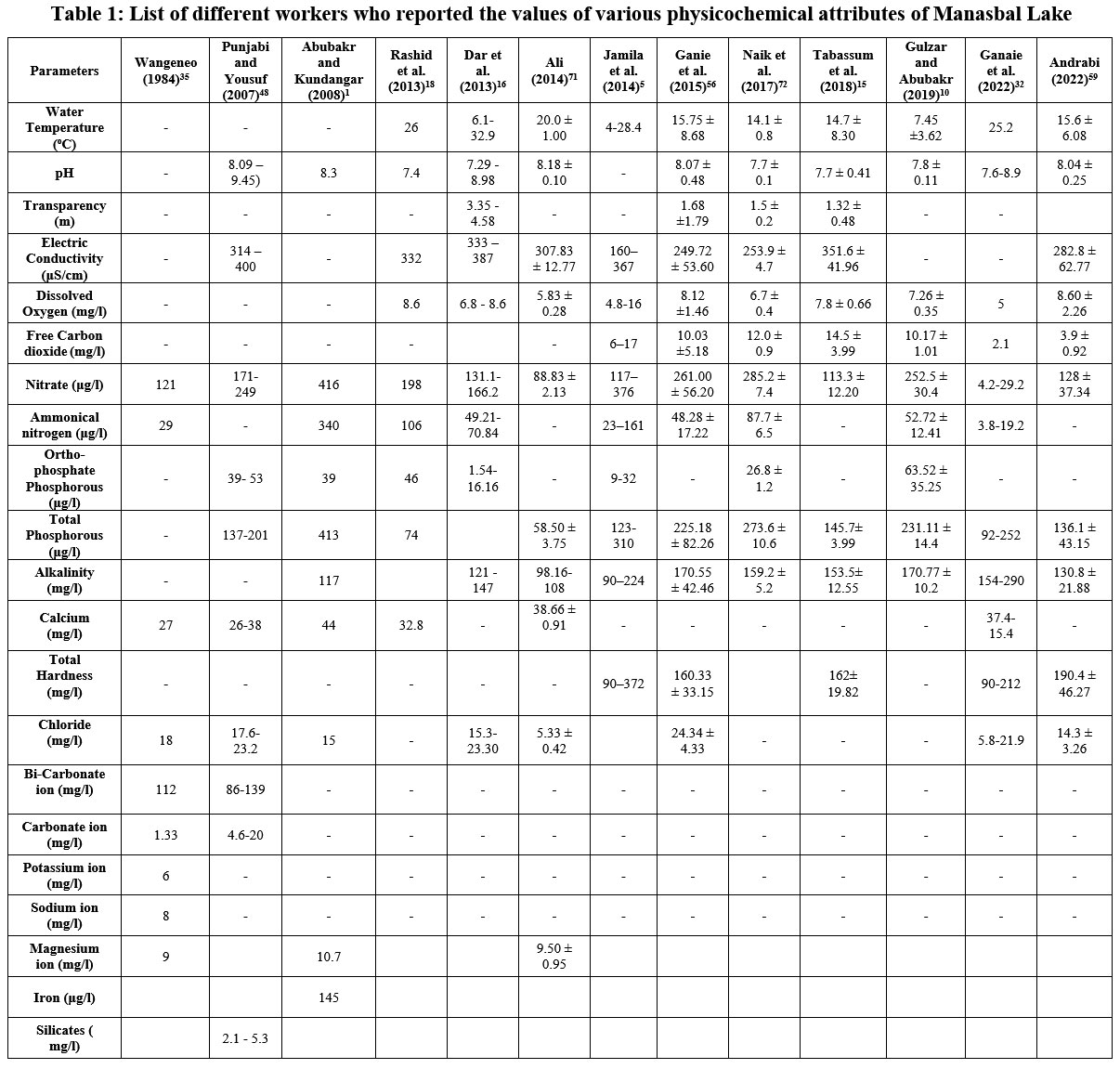 | Table 1: List of different workers who reported the values of various physicochemical attributes of Manasbal Lake
|
The combination of high pH and fluctuating DO levels poses significant challenges to the health of Manasbal Lake's ecosystem. High pH can exacerbate the toxicity of pollutants and disrupt nutrient cycles, while fluctuating DO levels stress aquatic life and contribute to ecosystem instability. Together, these factors can lead to a decline in water quality, loss of biodiversity, and a decrease in the ecological resilience of the lake. Addressing these issues requires integrated management strategies that focus on reducing pollution, controlling nutrient inputs, and maintaining stable water quality conditions to support a healthy and balanced aquatic ecosystem. Over the years, the abiotic factors in Manasbal Lake have exhibited significant variations, influenced by both natural seasonal changes and anthropogenic activities. The increasing trends in nutrient levels (nitrate, ammonical nitrogen, and phosphate) indicate heightened nutrient input, likely from agricultural runoff and other human activities. The consistent alkaline pH and fluctuations in dissolved oxygen levels suggest changes in photosynthetic activity and organic matter decomposition. The observed decrease in water transparency and increasing electrical conductivity point towards higher organic matter content and sedimentation. These changes collectively reflect an evolving ecological status, highlighting the need for ongoing monitoring and management to maintain the lake's health and biodiversity.
Implications of Physicochemical Attributes on Overall Manasbal Lake health
Alkaline Stress on Aquatic Life
High pH levels, as observed in Manasbal Lake (ranging from 7.29 to 8.98), can cause alkaline stress for many aquatic organisms. Fish and other aquatic life are sensitive to pH changes, and consistently high pH can affect their metabolism, reproductive success, and survival rates.
Increased Toxicity of Ammonia
At higher pH levels, ammonia (NH3) becomes more toxic. Ammonia is a common waste product in aquatic environments, and its toxicity can impair fish health, leading to reduced growth rates, gill damage, and increased susceptibility to diseases.
Influence on Nutrient Availability
High pH can alter the chemical forms of nutrients in the water, affecting their availability to aquatic plants and algae. For instance, it can lead to a higher availability of certain forms of phosphorus, potentially fueling algal blooms and contributing to eutrophication.
Fluctuating Dissolved Oxygen (DO) Levels
Impact on Aerobic Organisms
Fluctuating DO levels (ranging from 6.8 mg/l to 8.6 mg/l) can stress aerobic aquatic organisms. Fish and invertebrates rely on stable DO levels for respiration. Low DO levels can cause hypoxia, leading to suffocation and mortality in severe cases.
Ecosystem Imbalance
Variability in DO levels can disrupt the balance of aquatic ecosystems. Species that cannot tolerate low DO levels may be outcompeted by more tolerant species, leading to a shift in community structure and biodiversity loss.
Effects on Decomposition and Nutrient Cycling
DO levels influence the decomposition of organic matter and nutrient cycling. Low DO conditions can slow down aerobic decomposition processes, leading to the accumulation of organic matter. This can increase the demand for oxygen when conditions improve, creating a feedback loop that further exacerbates DO fluctuations.
Promotion of Anoxic Conditions
Persistent low DO levels can create anoxic conditions at the lake bottom, as noted in Manasbal Lake. Anoxic environments favor the release of nutrients like phosphorus from sediments, further promoting eutrophication and harmful algal blooms.
Water Temperature
Impact on Metabolic Rates
Water temperature influences the metabolic rates of aquatic organisms. Extremes in temperature (6.1°C to 32.9°C) can stress aquatic life, affect growth rates, and alter reproductive cycles.
Stratification and Mixing
Temperature differences can lead to thermal stratification, impacting oxygen distribution and nutrient cycling within the lake. Manasbal Lake remains stratified from March to November, which can lead to hypoxic conditions at the bottom.
Transparency
Light Penetration
Transparency values (3.35 to 4.58 m) affect light penetration, influencing photosynthesis and primary productivity.
Sedimentation
Reduced transparency due to sedimentation and pollution can limit photosynthetic activity and affect the food web.
Electric Conductivity
Indicator of Ionic Content
Electric conductivity (333 to 387 ?S/cm) reflects the ionic content of the water. High values may indicate pollution and nutrient loading.
Seasonal Variations
Conductivity changes with sedimentation and seasonal variations, influencing the lake's chemical balance.
Nutrient Levels (Nitrate, Ammonical Nitrogen, Phosphorus)
Eutrophication Risk
If the nutrient levels increase, it can lead to eutrophication, causing excessive growth of macrophytes eventually depleting oxygen levels.
Water Quality
Elevated nutrients ( nitrate 88.83 to 376 ?g/l, ammonical nitrogen 23 to 340 ?g/l, total phosphorus 58.50 to 310 ?g/l) indicate pollution from agricultural runoff and sewage, impacting overall water quality.
Alkalinity and Hardness
Buffering Capacity
Alkalinity (98.16 to 224 mg/l) and hardness (90 to 372 mg/l) influence the Manasbal Lake's buffering capacity against pH changes, maintaining a stable environment for aquatic life.
Overall Impact on Lake Health
The physicochemical attributes of Manasbal Lake significantly influence its overall health and ecological stability. High pH and fluctuating DO levels stress aquatic life and promote eutrophication. Elevated nutrient levels from human activities further exacerbate water quality issues, leading to algal blooms and oxygen depletion. Seasonal variations in temperature and conductivity affect stratification, sedimentation, and nutrient cycling, impacting the lake's biological and chemical processes. To maintain the health of Manasbal Lake, integrated management strategies are necessary. These should focus on reducing pollution, controlling nutrient inputs, enhancing afforestation efforts, and monitoring water quality to ensure a stable and balanced aquatic ecosystem.
Biotic Components of the Manasbal Lake
Primary Producers
Macrophytes
Manasbal Lake sustains a luxuriant macrophyte growth that is responsible for the fixation of large mass of organic carbon44. Vass (1980)29 recorded the following macrophytes in Manasbal Lake viz Ceratophyllum demersum, Najas graminea, Myriophyllum spicatum, Potamogeton pectinatus and Nelumbo nucifera. Siraj et al. (2018)44 compared the macrophyte diversity of littoral and limnetic parts of the lake and presented the abundance of the following species Phragmites australis, Cyprus sp., Nymphoides peltatum, Typha angustata, Nelumbo nucifera and Potamogeton natans in the littoral zone. However the limnetic zone of the lake shows the presence of C. demersum, M. spicatum, P. pectinatus, P. crispus, P. lucens and Hydrilla verticillata that can be grouped under 3 main forms of growth indicating significant vegetation zones is divided into distinct vegetational zones i.e:
Emergent type macrophytes include P. australis, T. angustata, and Cyperus sp., while floating type include N. nucifera, Euryle ferox and N. peltata and submerged type comprising H. verticilata, M. spicatum, C. demersum, P. pectinatus P. crispus and P. lucens. The growth of C. demersum in lake has been tremendously increasing during last years and resulted into vast stands.14 Macrophytes found in Manasbal Lake are shown in Figure 7.
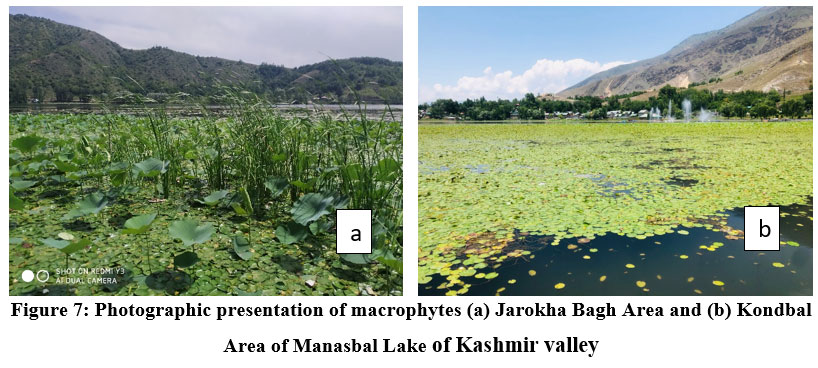 | Figure 7: Photographic presentation of macrophytes (a) Jarokha Bagh Area and (b) Kondbal Area of Manasbal Lake of Kashmir valley
|
Impact of Macrophyte Growth on Lake Ecology and Carbon Fixation in Manasbal Lake
Macrophyte Growth and Carbon Fixation
Manasbal Lake supports a diverse and abundant macrophyte community, which plays a crucial role in the fixation of organic carbon. The primary producers in the lake include various species of macrophytes, which are responsible for capturing and storing significant amounts of carbon through the process of photosynthesis. This process not only contributes to the primary productivity of the lake but also affects the overall carbon balance and sequestration in the ecosystem.
Specific Impacts on Lake Ecology
Primary Productivity
Macrophytes such as Ceratophyllum demersum, Najas graminea, Myriophyllum spicatum, Potamogeton pectinatus, and Nelumbo nucifera contribute to the high primary productivity of the lake. These plants convert carbon dioxide into organic matter, supporting the food web.
Habitat Provision
Different types of macrophytes provide essential habitats and shelter for various aquatic organisms. Emergent macrophytes like Phragmites australis and Typha angustata offer nesting sites and refuge for birds and insects, while submerged species such as H. verticillata and M. spicatum provide habitats for fish and invertebrates.
Oxygen Production
Through photosynthesis, macrophytes release oxygen into the water, which is crucial for maintaining dissolved oxygen levels. This supports aerobic aquatic life and helps mitigate anoxic conditions, particularly in the deeper parts of the lake.
Nutrient Cycling
Macrophytes absorb nutrients such as nitrogen and phosphorus from the water, reducing the risk of eutrophication. However, the decomposition of macrophyte biomass can also release nutrients back into the water, influencing nutrient cycling dynamics.
Sediment Stabilization
The roots of macrophytes stabilize lake sediments, reducing erosion and turbidity. This contributes to clearer water and enhances light penetration, further promoting photosynthetic activity.
Impact on Water Chemistry
The growth and decay of macrophytes can significantly influence water chemistry. For example, the decomposition of large biomass can lead to localized changes in pH and dissolved oxygen levels, impacting aquatic life.
Biodiversity Support
The diverse macrophyte communities in Manasbal Lake support a wide range of aquatic species, from microorganisms to larger vertebrates. This biodiversity is crucial for the resilience and stability of the lake ecosystem.
Carbon Sequestration
Macrophytes play a significant role in carbon sequestration by storing carbon in their biomass. When these plants die and settle at the bottom of the lake, the carbon is sequestered in the sediments, contributing to long-term carbon storage.
Macrophyte growth in Manasbal Lake has profound implications for the lake's ecological health and carbon fixation capabilities. By enhancing primary productivity, providing habitats, stabilizing sediments, and influencing nutrient cycling and water chemistry, macrophytes are integral to maintaining a balanced and healthy lake ecosystem. Sustainable management practices should focus on preserving and enhancing the macrophyte communities to ensure the continued ecological and carbon sequestration benefits they provide.
Phytoplankton
Various studies on the associations of plankton of the Manasbal Lake from the last 40 years or so34,37,45,46 are available. A total of 125 species of phytoplankton have been reported by Abubakr and Kundangar (2008)14 which includes the families viz Chlorophyceae, Bacillariophyceae and Cyanophyceae and other algal classes. The dominance order of different algal groups in terms of species composition, as identified by different researchers, revealing that Bacillariophyceae are dominant in the lake water46 followed by Cholorophyceae. In earlier, Vass (1980)29 described few dominant taxa of algal group viz Cyanophycaea (Spirulina jenneri, Oscillatoria proteus, Microcystis aeruginosa, Lyngbya), Chlorophyceae (Pediastrum duplex, Euastrum pulchellum, Gonium sp.), Pyrophyceae (Ceratium hirundinella, Peridinium sp.) and Chrysophyceae (Navicula radiosa, Asterionella formosa, Cocconeis placentula Cymbella sp. and Tabellaria sp.). Among these species the dominant forms are given as Oscillatoria proteus, S. jeneri, P. duplex C. hirundinella, N. radiosa, Cymbella sp. and Tabellaria sp. Akhter and Pandit (2014)47 reported 56 phytoplankton taxa which include 24 species of Bacillariophyceae, 16 species of Chlorophyceae, 14 species of Cyanophyceae, and one species of Euglenophyceae and Chrysophyceae. The abundance of Cyanophyceae and presence of Euglenophyceae near garbage dumping sites reveal the biotic fortification of these areas. The presence of both oligotrophic forms like Nitzchia sp. and eutrophic forms viz., Synedra sp. in the lake indicate modest pollution level of the lake47. The planktonic production estimated for Manasbal Lake is 240 – 475 Mg Cm2 day-1.29 However, the overall phytoplankton of Manasbal Lake was recorded 68.4 × 103 IL-1 which comprises 53.5 × 103 IL-1 of Bacillariophyceae, 10.0 × 103 IL-1 of Chlorophyceae and Cyanophyceae contributed 0.48 × 103 IL-1.14 Punjabi and Yousuf (2007)48 showed 34 diatom species related to 16 genus groups which include 7 species of Navicula, 5 species of Cymbella, 4 species of Amphora and 3 species belonging to Nitzschia.
Role of Phytoplankton in Manasbal Lake's Ecosystem
Primary Productivity
Phytoplankton are the primary producers in Manasbal Lake, forming the base of the aquatic food web, producing organic matter from carbon dioxide and sunlight, providing food for zooplankton, invertebrates, fish etc.
Nutrient Cycling
Phytoplankton play a vital role in nutrient cycling by absorbing the nutrients (phosphorus and nitrogen) from the water, which are essential for their growth. After death, these phytoplankton decompose and release the nutrients back into the water, making them available for other organisms.
Oxygen Production
Through the process of photosynthesis, phytoplankton produce oxygen, which is vital for the survival of aerobic aquatic life. This oxygen production helps maintain healthy dissolved oxygen levels in the lake, particularly in the upper water layers.
Indicators of Water Quality
The composition and abundance of phytoplankton species can indicate the trophic status and overall health of the lake. For instance, the presence of certain species of Bacillariophyceae (diatoms) and Chlorophyceae (green algae) can indicate good water quality, while the dominance of Cyanophyceae (blue-green algae) might suggest nutrient enrichment and potential eutrophication.
Food Source
Phytoplankton serve as a crucial food source for zooplankton and other small aquatic organisms. This, in turn, supports higher trophic levels, including fish and other predators, thereby sustaining the lake’s biodiversity.
In conclusion, Phytoplankton play a pivotal role in Manasbal Lake’s ecosystem by contributing to primary productivity, nutrient cycling, and oxygen production, thereby supporting a diverse and healthy aquatic community.
Epifauna
Bhat et al. (2012)49 while studying the invertebrate organisms associated with three species of macrophytes viz., C. demersum, H. verticillata and P. lucens, reported 15 macroinvertebrate taxa that belong to Arthopoda, Annelid and Mollusca which follows the dominance order as Arthopoda > Annelid > Mollusca. The Arthopoda phylum Insecta comprising (Odonata, Trichoptera, Lepidoptera, Coleopteran), Dipteral (Chironomidae, Culicidae, Rhagionidae, Tipulidae, Helidae), Crustacean (Gammarus, Tachinidae, Mites) and Annelida (Oligochaeta, Hirudinea), Mollusca (Lymnaeidae, Planorbidae).
Bacteria
According to the study regarding the bacterial flora of Manasbal Lake conducted by Shafi et al. (2013)50, the number of coliform bacteria ranges between 4 to 460 MPN/100 ml. The analysis of Manasbal Lake with respect to human induced pressures reported about 1391 bacterial colonies (Shafi et al., 2017)51 and showed significant deterioration of quality of lake water and designated the lake suitable for bathing purpose4,52. The percentage composition of bacterial species is given in Figure 8.
 | Figure 8: Percentage composition of bacterial species51
|
Implications of Bacterial Flora Findings for Lake Water Quality
Presence of Coliform Bacteria
The findings of coliform bacteria ranging between 4 to 460 MPN/100 ml indicate varying levels of fecal contamination in the lake water. High levels of coliform bacteria suggest the presence of pathogenic microorganisms, which can pose health risks to humans and animals using the lake for recreation, drinking, or other purposes.
Indicator of Pollution
The significant number of bacterial colonies and the presence of coliform bacteria suggest that the lake is subjected to pollution from human activities. This could be due to the influx of untreated sewage, agricultural runoff, or waste disposal into the lake.
Impact on Aquatic Life
High levels of pathogenic bacteria can adversely affect aquatic life. Fish and other aquatic organisms may be vulnerable to infections and diseases caused by these bacteria, which can disrupt the ecological balance of the lake.
Deterioration of Water Quality
The study by Shafi et al. (2017)51 highlighting 1391 bacterial colonies points to the significant deterioration of water quality. This deterioration can lead to decreased oxygen levels, higher nutrient loads, and overall degradation of the lake’s ecosystem.
Suitability for Bathing and Recreation:
Despite the high bacterial counts, the lake has been designated suitable for bathing purposes. However, this suggests a need for continuous monitoring and management to ensure that bacterial levels remain within safe limits to protect public health.
The bacterial flora findings, particularly the presence of coliform bacteria, highlight significant pollution issues that impact water quality and pose risks to both human health and aquatic life. These findings underscore the need for effective management and pollution control measures to maintain the ecological balance and health of Manasbal Lake.
Secondary Producers
Zooplankton
The freshwater zooplankton mainly includes Rotifers, Cladocerans, Copepodes and Ostracoda53. In littoral zone of lake, the Rotifera was found to be most dominant followed by Cladocera whereas Copepoda was least dominant while in case of limnetic zone of lake the dominance pattern was Cladocera > Rotifera > Copepoda44. The families viz., Branchionidae and Chydoridae predominate the littoral and limnetic zones respectively44. According to study of Yousuf (1988)54 Copepods share > 50% of zooplankton density in the Manasbal lake.
Rotifera phylum includes (Brachionidae Lepadellidae Synchaetidae Trichocercidae Notommatidae Lecanidae Bdelloidea) and the dominance order is followed as Brachionidae > Lecanidae > Lepadellidae > Notommatidae > Synchaetidae > Trichocercidae5. Rotifers richness can be considered due to their hasty heterogenetic recruitment potential, fewer periods of generation and low vulnerable biotic potential from crustaceans.55 Yousuf (1988)54 reported Copepods to occupy first position quantitatively contributing more than 50% to the total population density of zooplankton in the Manasbal Lake. Total number of 22 taxa of Cladocera having mean density of 134 individuals per liter was reported in Manasbal Lake17,56.
Table 2: List of zooplanktons reported from Manasbal Lake during different studies
Zooplankton Taxa | Zutshi et al. (1980)33 | Yousuf and Qadri (1981)38 | Jamila et al. (2014)5 | Siraj et al. (2018)44 |
Rotifera | ||||
Anuraeopsis fissa (Gosse) | + | |||
Brachionus quadridentata (Hermann) | + | + | + | |
Brachionus angularis (Gosse) | + | + | + | |
B calyciflorus (Pallas) | + | + | ||
B. plicatilis (Muller) | + | + | + | |
B. bidentata (Anderson) | + | + | ||
B. rubens | + | |||
Euchlanis dilatata (Ehrnberg) | + | + | ||
Keratella cochlearis (Gosse) | + | + | + | + |
K. quadrata (Muller) | + | + | + | + |
K. valga (Ehrenberg) | + | |||
Kellicottia longispina (Kellicot) | + | |||
Mytilina ventralis (Ehrenberg) | + | + | ||
M. mucronata (Muller) | + | + | + | |
Notholca acuminate (Gosse) | + | + | + | |
Platyias patulus (Muller) | + | + | + | |
P. quadricornis (Ehrenberg) | + | + | + | |
Platyias quadridentata | + | |||
Trichotria tetractis (Ehrenberg) | + | + | ||
Euchlanis dilatata (Ehrenberg) | + | |||
Polyarthra sp. | + | |||
Polyarthra vulgaris (Carlin) | + | + | + | |
P. dolicohoptera (Idelson) | + | |||
P. major | + | |||
Synchaeta oblonga (Ehrenberg) | + | + | ||
S. pectinata (Ehrenberg) | + | |||
Euchiants dilatata (Ehrenberg) | + | + | ||
E. parva (Rousellet) | + | |||
Asplanchna sp. | + | |||
Asplanchna priodonta (Gosse) | + | + | ||
Colurella sp. | + | |||
Colurella obtuse (Ehrenberg) | + | |||
Lepadella ovalis (Muller) | + | |||
L. patella (Muller) | + | |||
Squatinella mutica (Ehrenberg) | + | + | ||
Trichocerca longiseta (Shrank) | + | + | + | |
T. porcellus (Gosse) | + | + | ||
Trichocerca similis | + | |||
Trichocerca sp. | + | |||
Lecanei sp. | + | |||
Lecane luna (Muller) | + | + | ||
L. ohionsis (Herrick) | + | |||
L. elasma | + | |||
Monostvla sp. | + | |||
Monostyla bulla (Gosse) | + | + | + | |
M. quadridentata (Ehrenberg) | + | + | ||
M. closterocerca (Schmarda) | + | + | ||
M. lunaris (Ehrenberg) | + | + | ||
Cephalodella sp. | + | |||
Cephalodella auriculata (Ehrenberg) | + | |||
C. exigua (Gosse) | + | |||
C. gibba (Ehrenberg) | + | |||
Monommata sp | + | |||
Scandium sp. | + | |||
Notomata sp. | + | |||
Proales sp. | + | |||
Dicranophorus sp | + | |||
Filinia longiseta (Ehrenberg) | + | + | + | |
F. terminalis (Plate) | + | |||
Conochilus sp. | + | |||
Asplanchna sp. | + | |||
Asplanchna priodonta | + | |||
Philodina roseola (Ehrenberg) | + | |||
Gastropussp | + | |||
Hexarthra sp. | + | |||
Bdelloids | + | |||
Yousuf (1979)34 | Subla et al. (1984)73 | Pandit (1992)74 | Siraj (2011)75 | |
Cladocera | ||||
Acroperus harpae (Baird) | + | + | + | |
Alonopsis elongate (Sars) | + | |||
Alona affinis (Leydig) | + | + | + | |
A. costata | + | |||
A. guttata | + | + | + | |
A. rectangula | + | + | + | |
A.monocantha | + | + | ||
A. quadrangularis | + | + | ||
Alonella dentifera | + | |||
Alonella excisa | + | + | + | |
Alonella exigua | + | + | ||
Camptocercus rectirostris | + | + | + | |
Chydorus sphaericus (Muller) | + | + | + | + |
C. ovalis | + | |||
C. globosus | + | |||
C. eurynotus | + | |||
C. barroisi | + | |||
Eurycercus Sp. | + | |||
Eurycercus lamellatus | + | |||
Graptolebris testudinaria | + | + | + | + |
Pleuroxus sp. | + | |||
Pleuroxus denticulatus | + | |||
Pleuroxus uncinatus | + | |||
Pleuroxus aduncus | + | + | ||
Pleuroxus similis | + | + | ||
Pleuroxus trigonellus | + | |||
P. hastatus | + | |||
P. laevis | + | |||
Leydigia quadrangularis | + | |||
Ceriodaphnia reticulata (Jurine) | + | + | ||
Ceriodaphnia rectirostris | + | |||
Ceriodaphnia pulchella | + | |||
C. quadrangula (Muller) | + | + | ||
Daphnia sp. | + | |||
Daphnia laevis | + | + | + | |
Daphnia rosea | + | |||
D. magna | + | |||
D. pulex | + | + | ||
Scapholeberis mucronata | + | |||
Simocephalus vetulus | + | + | ||
Simocephalus exspinosus | + | |||
Diaphanosoma brachyurum (Lievin) | + | + | + | + |
Sida crystallina (Muller) | + | + | + | + |
Bosmina coregoni | + | + | ||
Bosmina longirostris | + | + | + | + |
Lathonura sp. | + | |||
Lathonura rectirostris | + | |||
Macrothrix rosea (Jurine) | + | + | ||
llyocryptus sordidus (Lievin) | + | |||
Leptodora hyaline (Lilljeborg) | + | + | ||
Moina micrura | + | |||
Anchistropus emarginatus | + | |||
Akhtar (1972)76 | Zutshi et al. (1980)33 | Yousuf (1988)54 | ||
Copepoda | ||||
Cyclops sp. | + | + | ||
cyclops scutifer (Sars) | + | + | ||
C. vicinus (Ulj.) | + | |||
C. ladakanus | + | |||
Eucyclops albidus (Jurine) | ||||
E. speratus (Lillj.) | + | |||
Macrocyclops albidus (Jurine) | + | + | ||
Mesocyclops leukarti (Claw) | + | + | ||
Megocyclops viridis (Jurine) | + | |||
Microcyclops bicolor (Kiefer) | + | |||
Thermocyclops crassus | + | |||
Acanthodiaptomus denticornis (Wierz.) | + | + | + | |
Allodiaptomus mirabilipes (Kiefer) | + | |||
Diaptomus sp. | + | |||
Pseudodiapromus lobipes (Gurney) | + | |||
Canthocamptus sp. | + | |||
Canthocamptus staphylinus | ||||
Canthocnmptus robertcokeri | + | |||
Ichthyofauna
The chief fish fauna in Kashmir valley mainly reflects the Central Asian fauna in which the Schizothoracine forms the principal group57. Yousuf in 198854 reported 12 fish species in Manasbal Lake of which economically significant ones are Schizothorax niger, Cyprinus carpio specularis, C. carpio communis, Triplophysa species. However other investigations revealed some commercially important fishes from the lake including S. niger, S. esocinus, S. curvifrons, S. plagiostomus, Tryplophysa species, C. carpio communis, C. carpio specularis, Neomacheilus latius and Ctenopharyngodon idella3,58,59. Botia birdi (Ram Gurun) extinction from the lake has been observed that was present ten years ago.18 The introduction of Cyprinus carpio as an exotic fish in Manasbal Lake was done in 195660.
Waterfowl
The lake harbors 51 bird species belonging to 14 orders and 25 families. Family Anatidae is found in the largest number of species (Figure 9) followed by Accipitridae which is followed by Corvidae and Muscicapidae61.
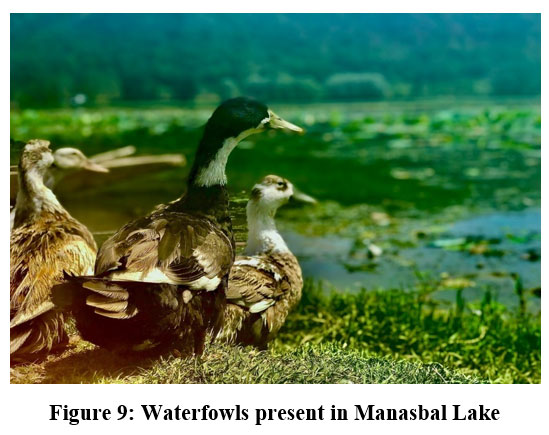 | Figure 9: Waterfowls present in Manasbal Lake
|
Environmental Concerns
Lakes and wetlands form large sink hole for carbon that shows fluctuations and joins ecology, weather and anatomy leading into a regular, high-resolution chronicle for exploring present and past climatic changes6,62. The different functions of lake include rejuvenation of groundwater, preservation of biological diversity along with habitat of the area and regulate the physicochemical characteristics of descending rivulets. Manasbal Lake is subjected to a wide range of external stresses, as a result, its surface area has reduced to 2.67 sq. km23. Its water quality is also deteriorating, posing serious hazards to local inhabitants and aquatic biotic life. The water quality of Manasbal Lake showed significant degradation in quality in view of global standards50 that is mainly the result of various ecological stresses due to anthropogenic activities. Also, on assessing the environmental risk of bottom sediment trace metals of Manasbal Lake, it has been concluded low to modest pollution of lake sediments6. The main factors of lake ecosystem degradation are:
Human Settlements and Intensified land use of Catchment Area
With the rapid growth of human population during last years, new human settlements have been established in the marginal area of the lake18 mainly contributing to the deterioration of lake by causing greater inflow of household refuse, sewage and garbage into the lake. According to Romshoo and Muslim (2011)63, wastelands and agriculture lands are the main source areas of nutrient pollution in a lake (Figure 10). These anthropogenic activities degrade the water quality and affect the biotic life in the lake, which results in increased eutrophication of these water bodies18. Pollution is menacing the biotic life especially fish however Nadru is being considered as endangered already. Large input of butachlor chemical in Manasbal Lake from nearby rice fields causes morpho-physiological alteration in general aquatic fauna and particularly Cyprinus carpio60. The conversion of forest areas into farms and agriculture resulted in breaching the ecosystem and thus large amounts of nutrients leach from the fertile upper soil of catchment area into the lake63. Also, agricultural runoff along with the insecticides and pesticides from nearby orchards and cultivable land seeps into the lake causing heavy loading of phosphorus and nitrogen in the lake63 as a result the water body is virtually chocked up with submerged weeds particularly during summer which is also the high tourist season.
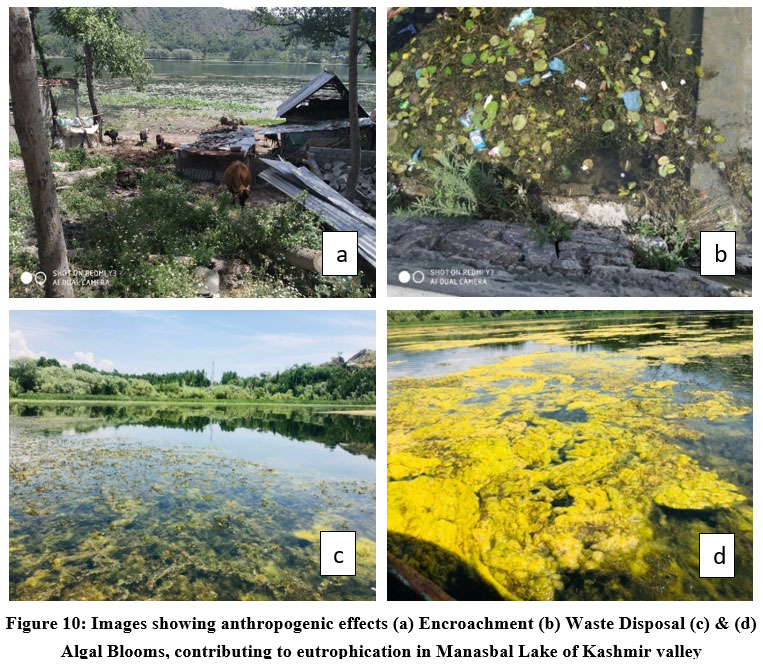 | Figure 10: Images showing anthropogenic effects (a) Encroachment (b) Waste Disposal (c) & (d) Algal Blooms, contributing to eutrophication in Manasbal Lake of Kashmir valley
|
High Tourist and Recreational Demand
The rapid inflation of tourist flow rate during recent years in Manasbal Lake has been reported by Magray and Jan (2014)23 that keeps the lake under high exploitation pressure. The extensive use of motor boats causes oil spills in water and results in deterioration of water body. The lake receives an inflow of phosphorus (4.36 tonnes) and of nitrogen (39.42 tonnes) every year14 thus virtually, the water body is seen plagued with submerged weeds, particularly during high tourist season (summer season). The water body is undergoing trophic evolution47 due to the fact that over the years, due to anthropogenic pressure, the lake has shown signs of eutrophication64,65.
Impact of Stone Quarrying
The processes like mining and quarrying occurring in the catchment area (Figure 11) of the lake have altered the morphological and physiological features of the lake18. Quarrying of limestone and furnace work in the area poses serious threat on physical, social and economic setting of lake viz geography, quality of air and water, top soil, noise, health and economic status, etc.66,67,68 Kondabal hill, with a huge proportion of limestone known for production of Gypsum through rock mines and kilns pours heavy loads calcium into the Manasbal Lake. Currently, there are approximately 16 gypsum-producing kilns in the region, with only two of them currently in operation. High sediment and nutrient loads in Manasbal Lake lead to the eradication of fish species like Botia birdi and a local flora viz., Eurayle ferox from the lake waters18. The removal of vegetation along with scrubs covering the hills because of quarrying process loosens the soil69 and causes fragmentation of habitat. There is considerable noise pollution during limestone quarrying and gypsum transportation leading loss of biodiversity in the area including humans70.
In 2007, the Jammu and Kashmir government established the Wular-Manasbal Development Authority (WMDA) with the aim of implementing rejuvenation measures for the betterment of Manasbal Lake. The WMDA employed various strategies to rehabilitate the lake and enhance its overall environmental conditions. However, the practical outcomes fell short of achieving satisfactory results.
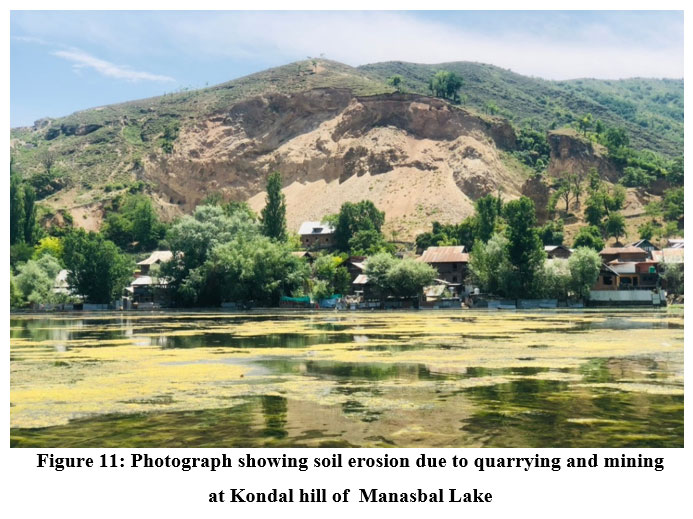 | Figure 11: Photograph showing soil erosion due to quarrying and mining at Kondal hill of Manasbal Lake
|
Restoration Measures
Watershed management: Implementing effective watershed management strategies is crucial for controlling agricultural runoff and pollution. Encouraging sustainable land use practices, such as afforestation and the creation of buffer zones, can help mitigate pollution entering Manasbal Lake. Government authorities should enforce regulations on land use and nutrient release into the lake, prioritizing specific actions within a defined timeframe.
Waste Diversion Strategies
Adopting waste diversion measures is a common practice to enhance water quality in eutrophic lakes like Manasbal, where sewage effluents contribute significantly to lake eutrophication. This approach is expected to lead to improvements in water quality, including increased transparency, species diversity, and a reduction in phytoplankton biomass and harmful chemicals.
Macrophyte Removal Strategies
The removal of macrophytes, has been widely employed in managing eutrophication in various water bodies. This method is particularly useful when macrophytes contribute substantially to eutrophication effects.
Aeration of lake Sediments for Ecological Improvement
The aeration of lake sediments is another viable method to prevent anaerobic conditions and enhance water quality through oxygenation, achieved by adding pure oxygen to the water. This approach can bring about positive changes in the lake's overall ecological condition.
Tourist management: Regulate and manage the tourism industry to minimize its impact on the lake. Promote eco-friendly tourism practices, reduce motorboat use, and implement waste management systems.
Pollution control: Upgrade and maintain sewage treatment facilities to reduce the discharge of pollutants into the lake. Create awareness among the local population about the importance of proper waste disposal.
Quarrying regulation: Enforce strict regulations on quarrying activities, including the mitigation of noise pollution, and ensure that the ecological impact is minimized. Promote responsible mining practices.
Biodiversity conservation: Implement strategies to safeguard the diverse aquatic and avian species within the lake. Monitor and regulate the fish population to maintain ecological equilibrium. Develop effective management protocols, considering the current threats to water biodiversity, fish, and waterbird species in accordance with wetland regulations.
Research and monitoring: Resources need to be allocated to regularly monitor water quality, nutrient levels, and the overall well-being of the lake. Utilize the gathered data to make well-informed decisions regarding conservation initiatives. Establish a robust monitoring mechanism for the Manasbal Lake. Preservation Programme, comprising distinguished limnologists, researchers, and experts with extensive experience in lake studies. This team should also include engineers, foresters, and academicians. Implement awareness campaigns, led by NGOs and educational institutions. Actively engage the local population residing near the lake, educating them about the repercussions of water pollution. Encourage research and development activities, including the use of online monitoring devices, similar to practices in other countries.
Expanding WMDA strategies through enhanced monitoring, pollution control, habitat restoration, community engagement, and stricter policy enforcement will help mitigate environmental degradation and ensure the long-term health of Manasbal Lake.
Conclusion
Manasbal Lake, a Kashmiri treasure, confronts environmental challenges jeopardizing its aesthetic appeal and biodiversity. Implementing restoration measures such as watershed management, regulated tourism, pollution control, quarrying oversight, biodiversity conservation, and ongoing research is crucial for safeguarding this precious ecosystem. The study is poised to provide a platform for advanced research into anthropogenic impacts as pollution indicators. Urgent action is imperative to preserve these natural resources; otherwise, we risk losing the benefits they offer. Robust management policies are necessary to prevent further degradation. Overall, the lake's water quality is deteriorating due to elevated concentrations of calcium, phosphorous, nitrogen, and chloride derivatives, impacting various water quality parameters. This pollution is associated with health issues in the nearby population reliant on this water source.
Acknowledgment
The authors are greatly indebted to the Head Department of Zoology, University of Kashmir for providing necessary facilities to compile the current research work.
Funding Sources
The author(s) received no financial support for the research, authorship, and/or publication of this article.
Conflict of Interest
The authors do not have any conflict of interest.
Data Availability Statement
This statement does not apply to this article.
Ethics Statement
This research did not involve human participants, animal, subjects, or any material that requires ethical approval.
Informed Consent Statement
This study did not involve human participants, and therefore, informed consent was not required.
Author's Contribution
Tabasum Yousuf: Conceptualization, Writing and Editing
Shaista Javaid: Writing and Tabulation
Sinan Nissar: Writing, Tabulation and Editing
Zahoor Ahmad Mir: Tabulation, Scrutinization and Editing
Yahya Bakhtiyar: Supervision, Writing and Editing
References
- Hassan, T. B., Arnold, R., Mishra, R. M. Comparative Physico-Chemical Limnology of Two Lakes of Kashmir Himalaya. Int J Multicul Multirel Underst. 2018;5(2):128-135.http://dx.doi.org/10.18415/ijmmu.v5i2.111.
CrossRef - Dewan, P. Parvéz Dewân's Jammû, Kashmîr, and Ladâkh (Vol. 2). Manas Publications, 2004.
- Zutshi, D. P., Vass, K. K. Ecology of macrophytic vegetation of Kashmir Lakes. In: Aquatic weeds in South East Asia, C.K. Varshney and Jr Rzoska (Eds). W. Junk, B. V. Publishers, The Hague;1976:141-146.
- Shafi, S., Kamili, A. N., Shah, M. A. Bacterial flora of Manasbal lake, A fresh water ecosystem of Kashmir valley. M. Phil. Thesis. University of Kashmir, 2012.
- Jamila, I., Yousuf, A. R., Parveen, M., Hassan, K., Rehman, M., Sheikh, B. A. Rotifer community in Manasbal lake of Kashmir. Int J Fish Aqua Stud. 2014;1(6):190-198.
- Lone, A., Babeesh, C., Achyuthan, H. Chandra, R. Evaluation of environmental status and geochemical assessment of sediments, Manasbal Lake, Kashmir, India. Arab J Geosci. 2017;10(4):92. DOI 10.1007/s12517-016-2826-7.
CrossRef - Gardner, W. S., Newell, S. E., McCarthy, M. J., Hoffman, D. K., Lu, K., Lavrentyev, P. J., Paerl, H. W.. Community biological ammonium demand: a conceptual model for cyanobacteria blooms in eutrophic lakes. Environ Sci Technol. 2017;51(14):7785-7793. https://doi.org/10.1021/acs.est.6b06296
CrossRef - Zutshi, D. P., Vass, K. K. Limnological studies on Dal lake-chemical features [India]. Indian J Ecol. 1978;5(1):90-97.
- Hutchinson, G. E. A treatise on limnology. 1957;1:243.
- Gulzar, B., Abubakr, A. Trophic status of Manasbal Lake: A high altitude deep lake water body of Kashmir, India. SKUAST Res. 2019;21(2):173-179.
- Yaseen, T., Bhat, S. U. Assessing the Nutrient Dynamics in a Himalayan Warm Monomictic Lake. Water Air Soil Pollut. 2021;232(3):1-21. https://doi.org/10.1007/s11270-021-05054-x
CrossRef - Yaseen, T., Yousuf, A. R. Impact of stratification on nutrient concentration in Manasbal lake, Kashmir. M. Phil. dissertation. University of Kashmir, 2012.
- Yousuf, T., Bakhtiyar, Y., Andrabi, S., Wani, G. B. Length-Weight Relationship and Condition Factor of Seven Fish Species in Manasbal Lake, Kashmir, India. Croat J Fish. 2023;81(1):13-22. https://doi.org/10.2478/cjf-2023-0002.
CrossRef - Abubakr, A., Kundangar, M. R. Ecological status of some floodplain lakes within Jhelum River basin, Kashmir. Nat Environ Pollut Technol. 2008;7(4):719-728.
- Tabassum, S., Tiwari, A., Mir, M. F. Current water quality status of a Monomictic Lake Kashmir. Int J Adv Res Sci Technol. 2018;7(4):2319-8354.
- Dar, J. A., Mir, M. F., Bhat, N. A., Bhat, M. A. Pollution Studies of a Monomictic Lake, Srinagar, Jammu and Kashmir. India. Forest Res. 2013;2(110):2. http://dx.doi.org/10.4172/2168-9776.1000110
CrossRef - Khare, N. Quaternary Climate Change Over the Indian Subcontinent. CRC Press, 2021
CrossRef - Rashid, I., Farooq, M., Muslim, M., Romshoo, S. A. Assessing the impact of anthropogenic activities on Manasbal Lake in Kashmir Himalayas. Int J Environ Sci. 2013;3(6):2036-2047. 10.6088/ijes.2013030600023
- Sarah, S., Jeelani, G. H., Ahmed, S. Assessing variability of water quality in a groundwater-fed perennial lake of Kashmir Himalayas using linear geostatistics. J Earth Sys Sci. 2011;120(3):399-411.
CrossRef - Wani, N. R., Mughal, A. H. Studies on vegetation analysis of the afforested bank of Manasbal Lake, Kashmir-India. J Horticul Fores Biotechnol. 2012;16(2):35-38.
CrossRef - Qadri, M. Y., Yousuf, A. R. Seasonal variation in the physico-chemical factors of a subtropical lake in Kashmir. J. Inland Fish Soc. India. 1978;10:89-96.
- Babeesh, C., Achyuthan, H., Jaiswal, M. K., Lone, A. Late Quaternary loess-like paleosols and pedocomplexes, geochemistry, provenance and source area weathering, Manasbal, Kashmir Valley, India. Geomorphology. 2017;284:191-205. https://doi.org/10.1016/j.geomorph.2017.01.004
CrossRef - Magray, A. A., Jan, T. Conservation Status of Manasbal Lake: A Case Study. Int J Sci Eng Res. 2014;5(3). 10.2139/ssrn.2207335
CrossRef - Wadia, D. N., Geology of India. Tata McGraw Hill Publishing Co, New Delhi, 1975.
- Babeesh, C., Achyuthan, H., Resmi, M. R., Nautiyal, C. M., Shah, R. A. Late Holocene paleoenvironmental changes inferred from Manasbal Lake sediments, Kashmir Valley, India. Quat Int. 2019;507:156-171. https://doi.org/10.1016/j.quaint.2019.02.017Get rights and content
CrossRef - Raza, M., Ahmad, A., Mohammad, A. The valley of Kashmir: A geographical interpretation. Vikas Publishing House, Pvt. Ltd, New Delhi, 1978.
- De Terra, H. Studies on the Ice-Age in India and associated human cultures. Publ. Carnegie Inst. 1939;493:354.
- Gansser, A. Geology of the Himalayas. Intersci. New York, 1964.
- Vass, K. K. On the trophic status and conservation of Kashmir lakes. Hydrobiol. 1980;68(1):9-15.
CrossRef - Kusumgar, S., Agrawal, D. P., Deshpande, R. D., Ramesh, R., Sharma, C., Yadava, M. A comparative study of monsoonal and non-monsoonal Himalayan Lakes, India. Radiocarbon. 1995;37(2):191-195. https://doi.org/10.1017/S0033822200030630
CrossRef - Bhat, A. A., Majumdar, K., Mishra, R. K. Political factors influencing residents’ support for tourism development in Kashmir. International Journal of Tourism Cities. 2022;8(3):718-740. DOI 10.1108/IJTC-03-2021-0052
CrossRef - Ganaie, D. B., Malhotra, A., Wani, I. A. Water quality assessment of Manasbal Lake in Kashmir. Water Sci. 2022;36(1):114-124. https://doi.org/10.1080/23570008.2022.2129149
CrossRef - Zutshi, D. P., Subla, B. A., Khan, M. A., Wanganeo, A. Comparative limnology of nine lakes of Jammu and Kashmir Himalayas. Hydrobiol. 1980;72(1):101-112. https://doi.org/10.1007/BF00016238
CrossRef - Yousuf, A. R. Limnology and fisheries of Manasbal lake. Ph.D. Thesis. University of Kashmir, 1979.
- Wanganeo, A. Primary production characteristics of a Himalayan lake in Kashmir. Internationale Revue der Gesamten Hydrobiologie und Hydrographie. 1984;69(1):79-90.
CrossRef - Vass, K. K. Primary Productivity and Hydrobiology of some Kashmir lakes. Doctoral dissertation, Ph.D. Thesis. University of Kashmir, 1973.
- Wanganeo, A. Phytoplankton photosynthesis, nutrient dynamics and trophic status of Manasbal Lake, Kashmir. Ph.D. Thesis. University of Kashmir, 1980.
- Yousuf, A. R., Qadri, M. Y. Seasonal distribution of family Chydoridae (Cladocera-Crustacea) in lake Manasbal, Kashmir. Journal of Inland Fisheries Society of India. 1981;13: 36-45. DOI:10.2298/ABS1303063B
CrossRef - Zutshi, D. P., Vass, K. K. High altitude lakes of Kashmir. Ichthiologica. 1970;10:12-15.
- Zutshi, D. P. Khan, M. A. On lake typology of Kashmir. Environ Physiol Plants. 1978;465-472.
- Khan, M. A., Zutshi, D. P. Primary productivity and trophic status of a Kashmir Himalayan Lake. Hydrobiol. 1980;68(1):3-8. https://doi.org/10.1007/BF00009057
CrossRef - Qadri, M. Y., Yousuf, A. R. Influence of physico-chemical factors on the seasonality of cladocera in lake Manasbal. Geobios. 1980;7(6):273-276.
- Naik, G., Rashid, M., Balkhi, M. H. Changes in physico-chemical parameters at different sites of Manasbal Lake of Kashmir, India. Fish. Aquac. J. 2015;6(148):2.
CrossRef - Siraj, S., Farooq, R., Shah, A. H. Influence of macrophytes on zooplankton distribution in Manasbal lake, Kashmir. SKUAST J. Res. 2018;20(2):153-158.
- Zutshi, D. P., Vass, K. K. Estimates of phytoplankton production in Manasbal Lake, Kashmir using carbon-14 method. Trop Ecol. 1977;18(2).
- Zutshi, D. P., Wanganeo, A. The phytoplankton and primary productivity of a high altitude subtropical lake. Internationale Vereinigung für theoretische und angewandte Limnologie: Verhandlungen. 1984:22(2):1168-1172. https://doi.org/10.1080/03680770.1983.11897457
CrossRef - Akhter, S., Pandit, A. K. Phytoplankton Dynamics of Manasbal Lake in Kashmir Himalaya. Int J Innovative Res Dev. 2014;4(3):5.
- Punjabi, U. N., Yousuf, A. R. Diatom Flora of Lake Manasbal during Summer. J Res Dev. 2007;7.
- Bhat, S. U., Dar, G., Sofi, A. H., Dar, N. A., Pandit, A. K. Macroinvertebrate community associations on three different macrophytic species in Manasbal Lake. Res J Environ Sci. 2012;16(2):62-76. DOI: 10.3923/rjes.2012.62.76
CrossRef - Shafi, S., Kamili, A. N., Shah, M. A. Coliform bacterial estimation: A tool for assessing water quality of Manasbal Lake of Kashmir, Himalaya. African J Microbiol Res. 2013;7(31):3996-4000. DOI: 10.5897/AJMR2013.5863
- Shafi, S., Kamili, A. N., Shah, M. A., Bandh, S. A. Isolation, identification and distribution of culturable bacteria in Manasbal Lake, Kashmir Himalaya. Proc Nat Acad Sci India Section B: Biol. Sci. 2015;87(1):115-120. DOI 10.1007/s40011-015-0582-1
CrossRef - Pandey, K. S., Sharma, S. D. Studies on water quality index for Ramganga River at Moradabad, Uttar Pradesh. Pollut Res. 1999;18(3):327-333.
- Jeelani, M., Kaur, H., Sarwar, S. G. Distribution of Rotifers in the Dal Lake, Kashmir, India. Pollut Res. 2005;24(1):79.
- Yousuf, A. R. Copepod plankton of lake Manasbal, Kashmir. Journal of the Indian Institute of Science. 1988;68(7&8):307.
- Sluss, T. D., Cobbs, G. A., Thorp, J. H. Impact of turbulence on riverine zooplankton: a mesocosm experiment. Freshwater Biol. 2008;53(10):1999-2010. https://doi.org/10.1111/j.1365-2427.2008.02023.x
CrossRef - Ganie, M. A., Parveen, M., Balkhi, M. H., Khan, M. I. Structure and diversity of cladoceran communities in two lakes with varying nutrient compositions in the Jhelum River Basin, Kashmir. International Journal of Fish Aqua Stud. 2015;3(2):456-462.
- Sunder, S., Bhagat, M. J., Joshi, C. B., Ramakrishna, K. V. Fishing methods and fish catch composition of Dal Lake, Kashmir (JandK) during 1969–72. J Inland Fish Soc India. 1979;10:9-18.
- Mehraj, S., Shah, T. H., Dar, S. A., Balkhi, M. H., Bhat, F. A., Bhat, B. A., Asimi, O. A. Catch composition of selected fishing gears operated in Manasbal lake, Kashmir. SKUAST J Res. 2018;199.
- Andrabi, S. Studies on demography and management of Cyprinus carpio L in Manasbal Lake Kashmir. Doctoral dissertation, Ph. D thesis, University of Kashmir, 2022.
- Qurashi, M. A., Hassan, S. M., Shah, G. A. Effect of butachlor on haematological profile of exotic carp, Cyprinus carpio var communis (Linn) of Manasbal Lake of Kashmir valley. Int J Fauna Biol Stud. 2017;4(1):110-112.
- Wani, H. M., Nazir, U., Structural Assemblage of Avian Community in Manasbal belt, Jammu and Kashmir. Indian Forester. 2020;146(12):1176-1180. DOI:10.36808/if/2020/v146i12/156771
CrossRef - Schnurrenberger, D., Russell, J., Kelts, K. Classification of lacustrine sediments based on sedimentary components. J Paleolimnol. 2003;29(2):141-154. DOI:10.1023/A:1023270324800
CrossRef - Romshoo, S. A., Muslim, M. Geospatial modeling for assessing the nutrient load of a Himalayan Lake. Environ Earth Sci. 2011;64(5):1269-1282. DOI:10.1007/s12665-011-0944-9
CrossRef - Pandit, A. K., Yousuf, A. R. Trophic status of Kashmir Himalayan lakes as depicted by water chemistry. J Res Dev. 2002;2:1-2.
- Pandit, A. K., Yousuf, A. R. Rotifer community in some Kashmir Himalayan lakes of varied trophic status. J Res Dev. 2003;2:1-2.
- Chauhan, S. S. Mining, development and environment: a case study of Bijolia mining area in Rajasthan, India. J Human Ecol. 2010;31(1):65-72. DOI:10.1080/09709274.2010.11906299
CrossRef - Reza, R., Singh, G. Impact of industrial development on surface water resources in Angul region of Orissa. Int J Environ Sci. 2010;1(4):514-522.
- Naja, G. M., Rivero, R., Davis, S. E., Van Lent, T. Hydrochemical impacts of limestone rock mining. Water Air Soil Pollut. 2011;217(1):95-104. DOI:10.1007/s11270-010-0570-2
CrossRef - Darwish, T., Khater, C., Jomaa, I., Stehouwer, R., Shaban, A., Hamzé, M. Environmental impact of quarries on natural resources in Lebanon. Land Degradation and Development, 2011;22(3):345-358. DOI:10.1002/ldr.1011
CrossRef - Fletcher, J. L., Busnel, R. G. Effects of Noise on Wildlife. Academic Press, New York, 1978.
- Ali, U. Stress of environmental pollution on zooplanktons and their comparative studies in Dal Lake, Wular lake Anchar lake and Manasbal Lake. Srinagar, Kashmir. Int J Eng Sci. 2014;3:39-44.
- Naik, G., Balkhi, M. H., Bhat, F. A., Rashid, M. Comparative study of present and past cladoceran diversity in Manasbal lake of Kashmir (India). J Fish Sci. 2017;11(1):62. DOI:10.21767/1307-234X.1000110
CrossRef - Subla, B. A., Zutshi, D. P., Vishin, N., Wanganeo, A. Distribution and structure of zooplankton communities from Kashmir. Bull Environ Sci. 1984;1:30-35.
- Pandit, A. K. Biotic communities in relation to trophic conditions in Kashmir lakes. Ph. D. thesis, University of Kashmir. 1992.
- Siraj, S. Micro and macro-zoobenthos of three different water bodies of Kashmir. Ph.D. Thesis. University of Kashmir. 2011.
- Akthar, S. Qualitative and quantitative studies on freshwater plankton, Rotifera, Cladocera, Ostracoda and Copepoda of Kashmir lakes and ponds. Ph. D thesis, University of Kashmir. 1972.







